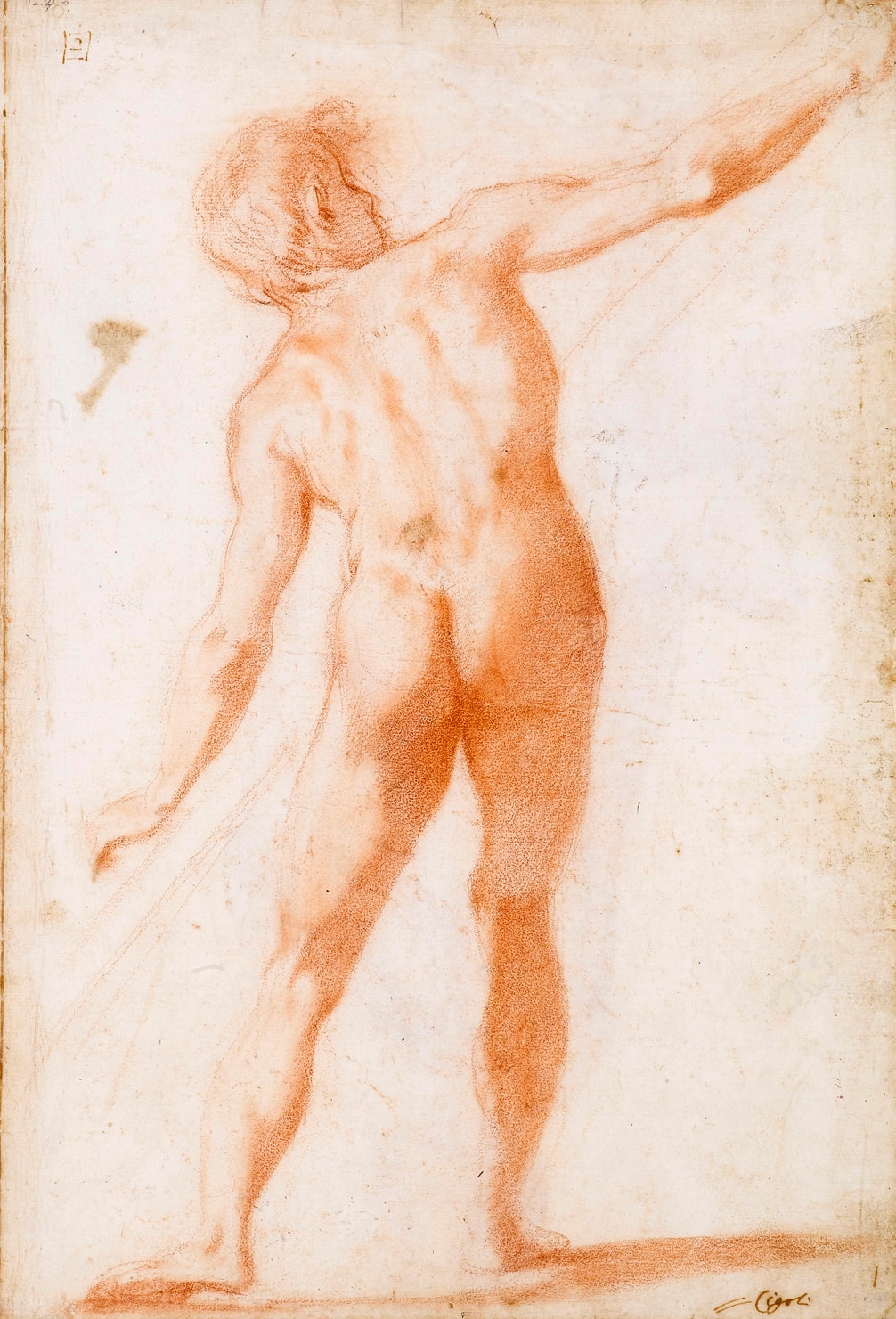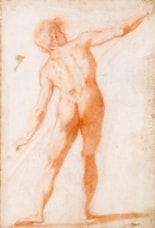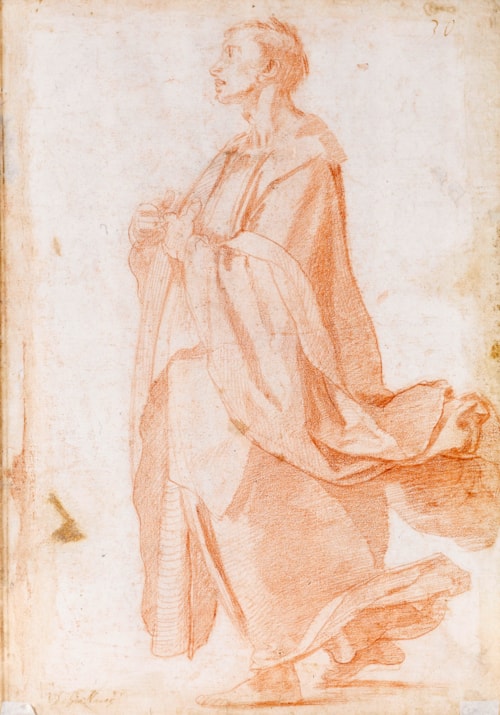Ludovico Cardi CIGOLI
(Castello di Cigoli 1559 - Rome 1613)
Recto: Study of a Male Nude, Seen from Behind [recto]; Study of a Draped Figure, Striding to the Left [verso]
Sold
Red chalk. Mount lines in brown ink at the left edge.
Inscribed Cigoli at the lower right and numbered 2 in a box at the upper left.
Inscribed Cig- at the lower right and faintly inscribed Di Gio Navez at the lower left on the verso.
413 x 282 mm. (16 1/4 x 11 1/8 in.)
Inscribed Cigoli at the lower right and numbered 2 in a box at the upper left.
Inscribed Cig- at the lower right and faintly inscribed Di Gio Navez at the lower left on the verso.
413 x 282 mm. (16 1/4 x 11 1/8 in.)
Filippo Baldinucci credits Cigoli with reestablishing the principles of life drawing among the painters of Florence, and his studies from life, invariably executed in red chalk, are an integral part of his graphic output. As a young artist, Cigoli, along with Gregorio Pagani and Domenico Passignano, established a private and informal drawing academy in a rented studio in Florence, in which the artists drew from posed models.
Neither of the figure studies on the recto and verso of this splendid drawing can be definitively related to a surviving painting by Cigoli. Miles Chappell has, however, tentatively suggested that the male nude may be a first idea for the pose of the angel in Cigoli’s altarpiece of The Resurrection, painted in 1590 for the Palazzo Pitti. Long thought to be lost and only recently rediscovered, the painting was one of Cigoli’s first Medici commissions, and marked the beginning of his successful career. The figure of an angel for which Chappell posits this drawing may be a study is in the middle ground of the composition, partially obscured by a soldier. The male nude in this drawing appears to be lifting or holding a rectangular object, only faintly drawn in red chalk, which may perhaps be identified as the tomb slab that the angel lifts in the painting. Chappell has further suggested that the draped figure on the verso of the present sheet may be related to one of the figures in the background of the same painting, an area that is no longer legible due to the poor condition of this part of the canvas.
The male nude on the recto of present sheet may also be a first idea for a figure in another painting by Cigoli of the early 1590’s; the Siege of Jerusalem in the National Gallery of Ireland in Dublin, in which a group of soldiers raising a ladder is prominent at the right edge of the composition. In this context, it is in particularly interesting to note the very similar pose of a soldier in a painting of the same subject of The Siege of Jerusalem by Cigoli’s teacher, Santi di Tito. Painted in 1589 as part of the temporary decorations for the marriage of Ferdinando de’Medici and Christina of Lorraine, Santi di Tito’s painting is now known only through an engraving of it used to illustrate an account of the wedding festivities, published in 1589.
The pen inscription ‘Cigoli’ at the lower right of the recto of the present sheet is identical to that found in drawings by the artist in the Uffizi and elsewhere, as well as in a group of chalk drawings by Cigoli, from an 18th century Florentine collection, which appeared at auction in London in 1985. Miles Chappell has suggested that this inscription – certainly by someone close to the artist - may be in the hand of Cigoli’s nephew and biographer, Giovanni Battista Cardi.
Another of the drawings with this ‘Cigoli’ inscription, now in the British Museum, also bears the same inscription ‘Di Gio Navez(?)’ found on the verso of the present sheet. This has been recently identified by Miles Chappell as referring to the 17th century artist and collector Cavaliere Giovanni Navarrette (died c.1652), of whom little is known today, who seems to have owned a number of drawings by Cigoli.
Neither of the figure studies on the recto and verso of this splendid drawing can be definitively related to a surviving painting by Cigoli. Miles Chappell has, however, tentatively suggested that the male nude may be a first idea for the pose of the angel in Cigoli’s altarpiece of The Resurrection, painted in 1590 for the Palazzo Pitti. Long thought to be lost and only recently rediscovered, the painting was one of Cigoli’s first Medici commissions, and marked the beginning of his successful career. The figure of an angel for which Chappell posits this drawing may be a study is in the middle ground of the composition, partially obscured by a soldier. The male nude in this drawing appears to be lifting or holding a rectangular object, only faintly drawn in red chalk, which may perhaps be identified as the tomb slab that the angel lifts in the painting. Chappell has further suggested that the draped figure on the verso of the present sheet may be related to one of the figures in the background of the same painting, an area that is no longer legible due to the poor condition of this part of the canvas.
The male nude on the recto of present sheet may also be a first idea for a figure in another painting by Cigoli of the early 1590’s; the Siege of Jerusalem in the National Gallery of Ireland in Dublin, in which a group of soldiers raising a ladder is prominent at the right edge of the composition. In this context, it is in particularly interesting to note the very similar pose of a soldier in a painting of the same subject of The Siege of Jerusalem by Cigoli’s teacher, Santi di Tito. Painted in 1589 as part of the temporary decorations for the marriage of Ferdinando de’Medici and Christina of Lorraine, Santi di Tito’s painting is now known only through an engraving of it used to illustrate an account of the wedding festivities, published in 1589.
The pen inscription ‘Cigoli’ at the lower right of the recto of the present sheet is identical to that found in drawings by the artist in the Uffizi and elsewhere, as well as in a group of chalk drawings by Cigoli, from an 18th century Florentine collection, which appeared at auction in London in 1985. Miles Chappell has suggested that this inscription – certainly by someone close to the artist - may be in the hand of Cigoli’s nephew and biographer, Giovanni Battista Cardi.
Another of the drawings with this ‘Cigoli’ inscription, now in the British Museum, also bears the same inscription ‘Di Gio Navez(?)’ found on the verso of the present sheet. This has been recently identified by Miles Chappell as referring to the 17th century artist and collector Cavaliere Giovanni Navarrette (died c.1652), of whom little is known today, who seems to have owned a number of drawings by Cigoli.
The leading painter in Florence at the end of the 16th century, Lodovico Cardi, known as Cigoli from the Tuscan village of his birth, occupies a significant role in the transition from Late Mannerism to the Baroque in Tuscany. He was a pupil of Bernardo Buontalenti, Alessandro Allori and Santi di Tito, and was admitted into the Accademia del Disegno in 1578, at the age of nineteen. Among his first Medici commissions was an altarpiece of The Resurrection for a small chapel in the Palazzo Pitti, painted in 1590, which was strongly influenced by Santi’s version of the subject in the church of Santa Croce, painted some fifteen years earlier. A number of important altarpieces for various Florentine churches executed throughout the late 1580’s and 1590’s culminated in the large Martyrdom of Saint Stephen, painted in 1597 for the convent of Montedomini.
In the first years of the 17th century Cigoli worked for the Medici, decorating the vaults of several rooms in the Palazzo Pitti, assisted by his pupil Cristofano Allori, and also providing designs for pietra dura panels for the ciborium of the Cappella dei Principi in the church of San Lorenzo. In 1604 Cigoli moved to Rome, where he worked for the remainder of his career and was awarded some of the most prestigious artistic commissions of the day. These included altarpieces for the basilica of St. Peter’s and the church of San Paolo fuori le Mura, as well as the frescoed cupola of the Cappella Paolina of Santa Maria Maggiore. Between 1611 and 1613 he decorated the Loggia di Psiche for the Roman villa of Cardinal Scipione Borghese, and he continued to divide his time between Rome and Florence until his death in 1613.
As a draughtsman, Cigoli has long been greatly admired by his collectors and connoisseurs. He drew in a variety of media and with a fluency of technique in chalk, pen and brush, leading one recent scholar to note that Cigoli was ‘an artist who delighted in drawing as an end in itself.’ The Florentine historian and biographer Filippo Baldinucci, an avid collector of the artist’s drawings, wrote of Cigoli that ‘he drew constantly, and his drawings, done in a style that is his own, display...[a] spontaneity and appealing delicacy of touch, the perfection of the whole and knowledge of anatomy, a certain immediacy and spirit, never known to me except in those of the great Michelangelo...the spirit of one and the other, particularly in the sketches, is such that at first glance one finds an immediacy deriving not from the parts but from the whole; an immediacy that inspires awe in the beholder’.
A considerable number of drawings by Cigoli, numbering well over a thousand sheets, survive today, with by far the greatest number in the collection of the Uffizi in Florence; other significant groups of drawings by the artist are in the Louvre and the Istituto Nazionale per la Grafica in Rome.
Provenance
Cavaliere Giovanni Navarette, Pisa (his inscription ‘Di Gio Navez’ on the verso)
Comte Eugène d’Oultremont, Chateau de Presles, Aiseau-Presle, Belgium, and thence by descent until c.1985
Private collection, Brussels.
Literature
Ixelles, Musée Communal, De Giorgione à Tiepolo: Dessins italiens du 15e au 18e siècle dans les collections privées et publiques de Belgique, exhibition catalogue 1993, pp.120-121, no.50 (entry by Miles Chappell); Miles Chappell, ‘On the Artist and Collector Giovanni Navarrette’, Commentari d’Arte, Vol.XIV, No.41, 2008, pp.68-70, figs.2, 4 and 5.





